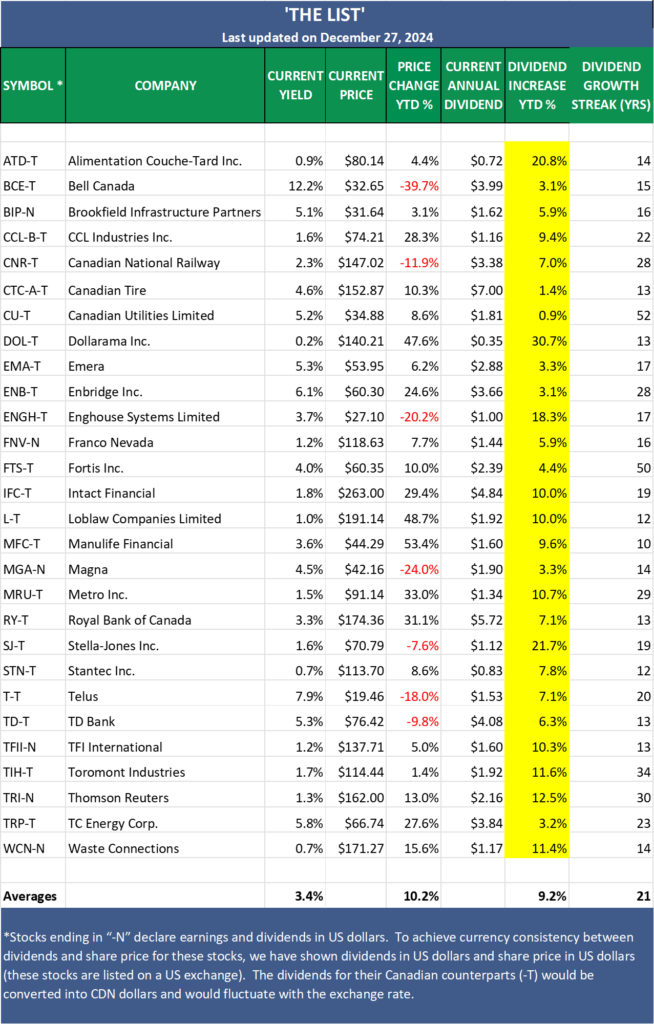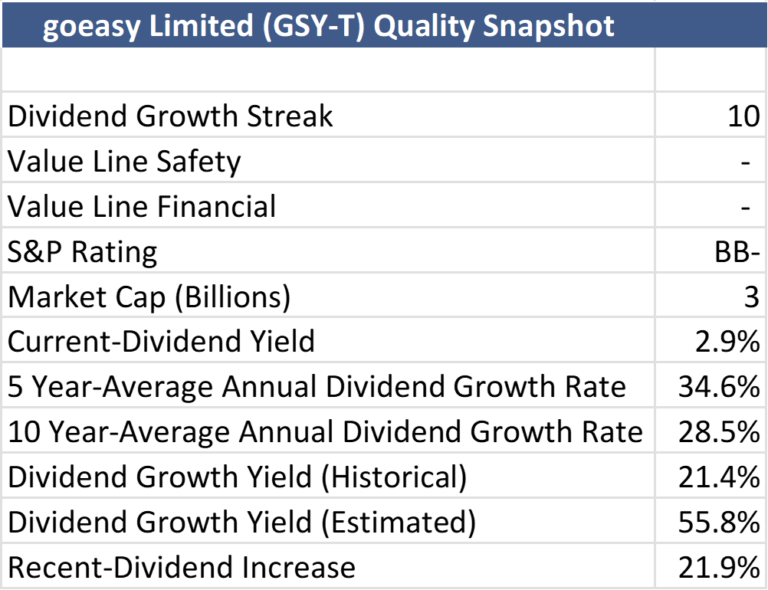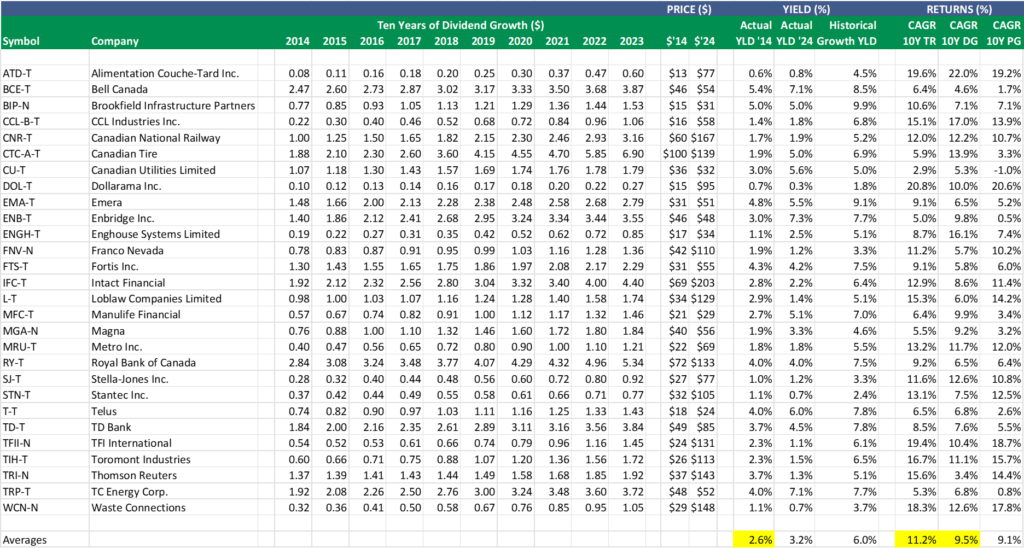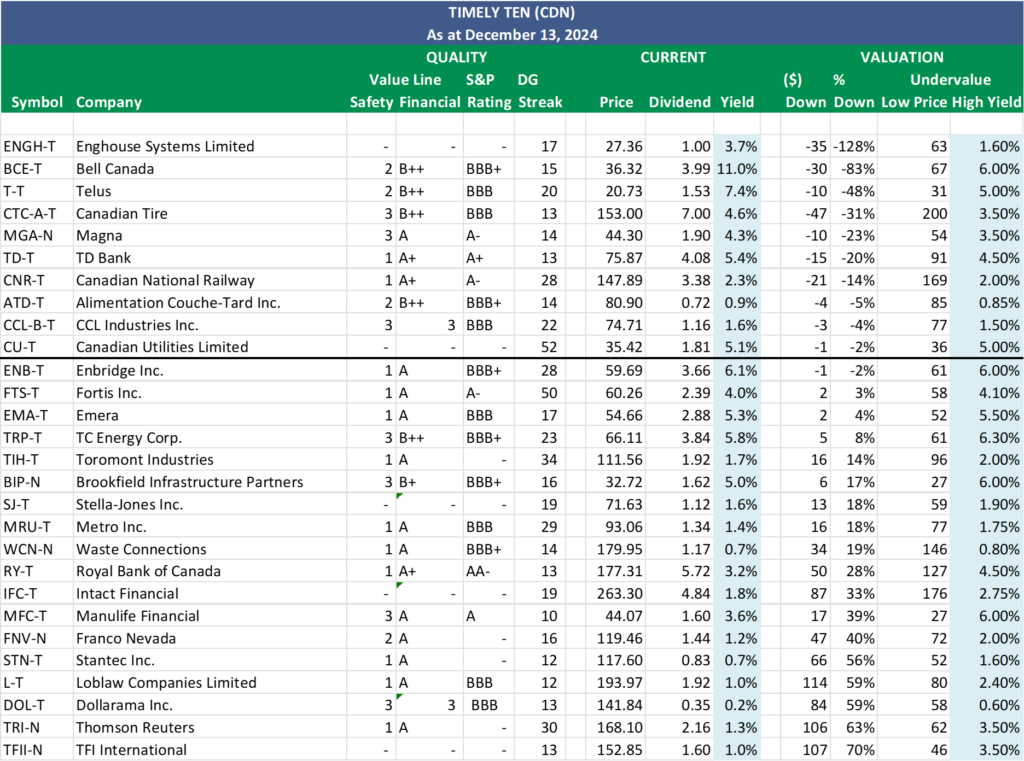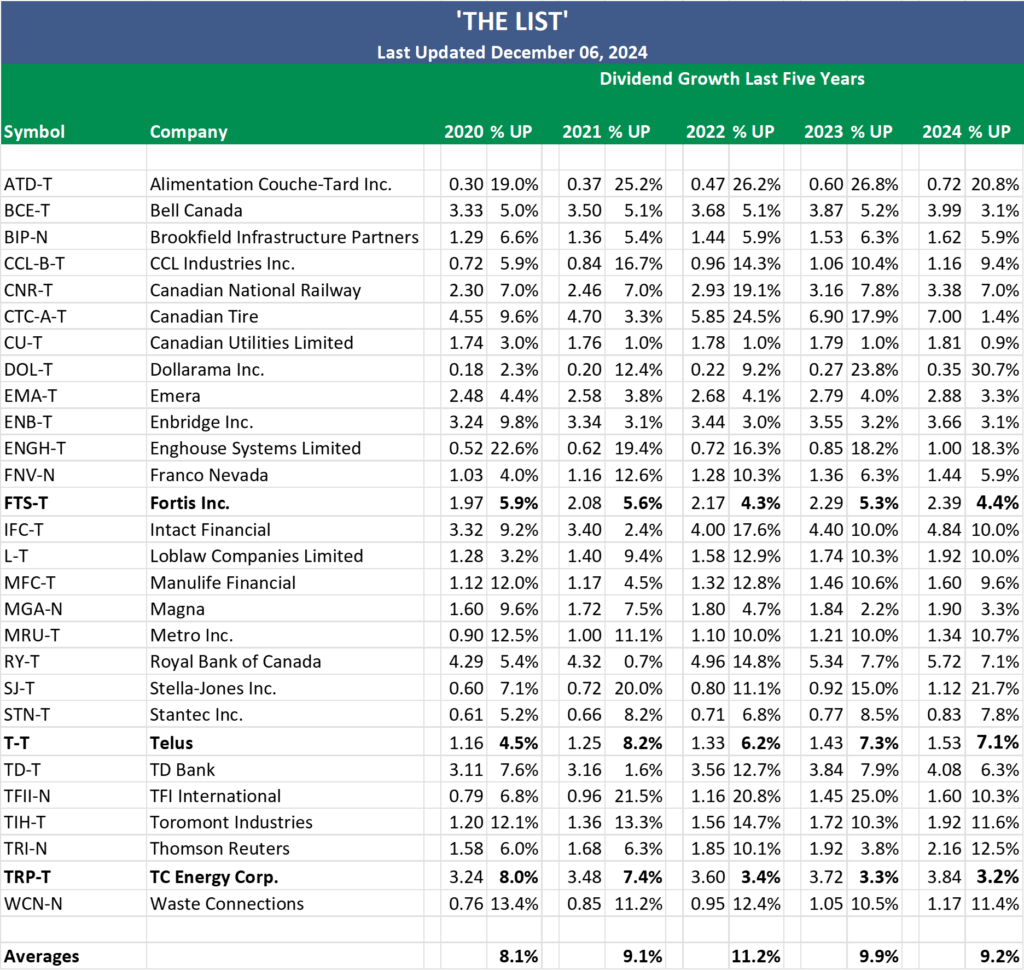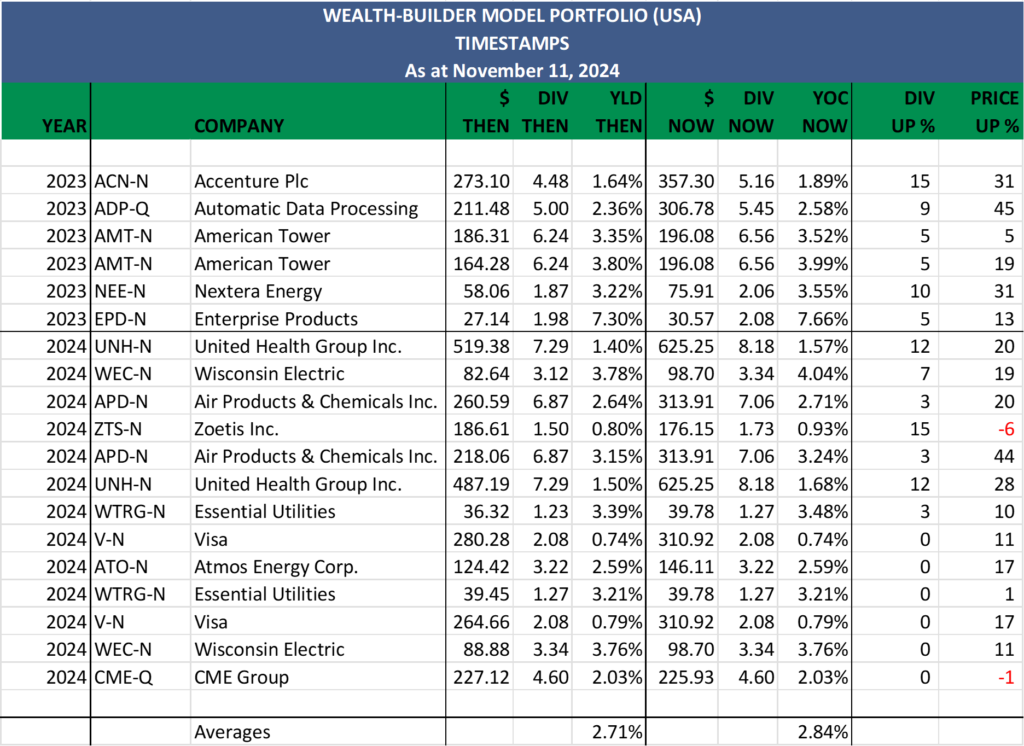MP Market Review – January 3, 2025
Last updated by BM on January 7, 2025
Summary
This is a weekly installment of our MP Market Review series, which provides insights and updates on Canadian dividend growth companies we monitor on ‘The List’. To read all our newsletters and premium content be sure to check us out on magicpants.substack.com.
- This week, we introduce our new 2025 version of ‘The List-USA’. Next week’s newsletter will update both watchlists.
- Last week, ‘The List’ ‘s dividend growth got a head start from dividends already announced for 2025. Dividend growth is up by +2.3% YTD (income).
- Last week, the price of ‘The List’ was up with a return of +0.7% YTD (capital).
- Last week, there were no dividend announcements from companies on ‘The List’.
- Last week, there were no earnings reports from companies on ‘The List’.
- This week, no companies on ‘The List’ are due to report earnings.
DGI Clipboard
“If you look for companies that can raise their dividends year after year without milking operations, you will automatically be lead to high quality stocks.”
– Edmund Faltermayer, Fortune magazine, October 1990
America’s Dividend Growth Leaders: Our 2025 Watch List-USA

Intro
Reflecting on 2024 and Looking Ahead
Another year is in the books, and it’s time to gear up for what lies ahead. Overall, 2024 was a strong year for index investors, with many benchmark indexes reaching new highs. Optimism was fueled by receding inflation, lower interest rates, advances in AI, renewed interest in cryptocurrencies, and shifts in the U.S. political landscape.
However, as seasoned investors know, a single year’s performance doesn’t tell the full story. It’s the consistent, compounding results over 5, 10, or more years that truly matter.
That’s why, as dividend growth investors, we focus on the metric that matters most in the short term: growing cash flow. Reflecting on 2024, there’s really one key question for us: How much did our income grow?
We’re proud to report that every company on ‘The List’—our curated watchlist of high-quality dividend growth companies—increased their dividends in 2024. The average income growth from ‘The List’ was an impressive 9.2%, aligning with historical dividend growth rates of 8.1%, 9.1%, 11.2%, and 9.9% over the past four years.
If you’re following along with our model dividend growth portfolio—or managing a similar DGI portfolio—you’ve likely experienced similar results. While capital appreciation is inevitable as dividends grow, it’s important to stay focused on what we control: the growing income our investments provide.
Never lose sight of our unique approach. As the dividend grows, so does the value of the portfolio. Patience and discipline remain the cornerstones of dividend growth investing.
Here’s to another year of building wealth, one dividend at a time!
Introducing ‘The List-USA’: A Watchlist of Quality American Dividend Growth Companies
In 2025, we are excited to publicly launch ‘The List-USA’, our curated watchlist of high-quality American dividend growth companies, alongside the MP Wealth-Builder Model Portfolio (USA). This initiative builds on the proven methodology we use for Canadian dividend growth companies and applies it to the vast U.S. market.
What is ‘The List-USA’?
It’s important to note that ‘The List-USA’ is not a portfolio but a powerful coaching tool designed to inspire ideas and help us effectively manage risk in building the MP Wealth-Builder Model Portfolio (USA). While we own some of the companies on the list, it primarily serves as a resource for identifying potential opportunities when valuations become attractive.
How We Build ‘The List-USA’
The creation of this watchlist involves a disciplined and rigorous screening process.
Initial Screening Criteria:
- Dividend Growth: Companies must have a minimum of 10 consecutive years of dividend growth.
- Market Capitalization: A market cap of $1 billion or more is required.
This step narrows the field of NYSE and NASDAQ listed companies to approximately 350 candidates.
Refinement Through Final Criteria:
- Diversification: We limit the watchlist to five companies per sector, with no more than two companies from the same industry.
- Cyclicality: To manage risk, we exclude REITs and pure-play energy companies due to their higher cyclicality.
After this extensive filtering and evaluation process, we arrive at the finalized USA Watchlist for 2025.
Why It Matters
This watchlist offers a strategic foundation for dividend growth investors looking to build a high-quality U.S.-focused portfolio. It’s designed to encourage thoughtful decision-making, focusing on both income growth and long-term stability.
It is now time to reveal ‘The List-USA’—your guide to quality dividend growth investing in the United States.
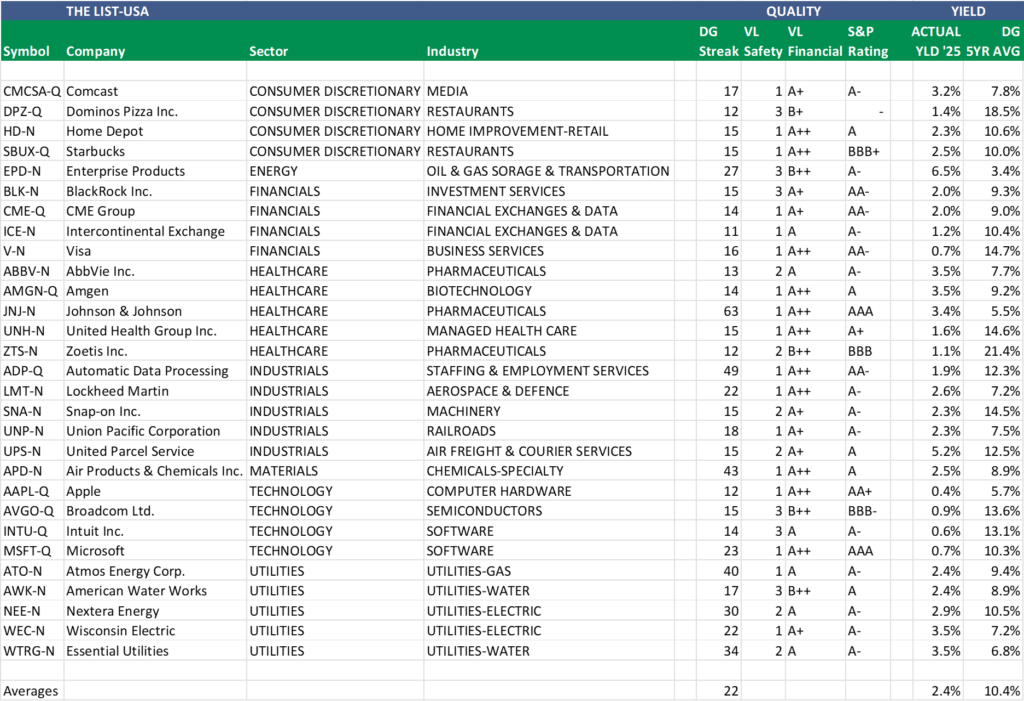
Wrap Up
The inaugural USA Watchlist features 29 high-quality companies spanning eight key sectors of the American economy. This diverse selection offers a broad range of starting dividend yields and growth rates, catering to various investment strategies and goals.
Designed with care, this watchlist serves as a robust foundation for building our MP Wealth-Builder Model Portfolio (USA) while providing a structured guide to refine and coach our investment process.
Whether you’re seeking consistent income or long-term growth, this watchlist is your gateway to constructing a resilient and rewarding portfolio.
Become a paid subscriber and start building your portfolio confidently today. We do the work, and you stay in control!
DGI Scorecard
The List (2025)
The Magic Pants 2025 lists include 29 dividend growth stocks. Here are the criteria to be considered a candidate on ‘The List’:
- Dividend growth streak: 10 years or more.
- Market cap: Minimum one billion dollars.
- Diversification: Limit of five companies per sector, preferably two per industry.
- Cyclicality: Exclude REITs and pure-play energy companies due to high cyclicality.
Based on these criteria, companies are added or removed from ‘The List’ annually on January 1. Prices and dividends are updated weekly.
‘The List’ is not a portfolio but a coaching tool that helps us think about ideas and risk manage our model portfolio. We own some but not all the companies on ‘The List’. In other words, we might want to buy these companies when valuation looks attractive.
Our newsletter provides readers with a comprehensive insight into the implementation and advantages of our Canadian dividend growth investing strategy. This evidence-based, unbiased approach empowers DIY investors to outperform both actively managed dividend funds and passively managed indexes and dividend ETFs over longer-term horizons.
For those interested in something more, please upgrade to a paid subscriber; you get the enhanced weekly newsletter, access to premium content, full privileges on the new Substack website magicpants.substack.com and DGI alerts whenever we make stock transactions in our model portfolio.
Performance of ‘The List’
Last week dividend growth of ‘The List’ got a head start from dividends already announced for 2025. Dividend growth is up by +2.3% YTD (income). Dividend increases announced in 2025 will further contribute to this growth.
Last week, the price of ‘The List’ was up with a return of +0.7% YTD (capital).
Even though prices may fluctuate, the dependable growth in our income does not. Stay the course. You will be happy you did.
Last week’s best performers on ‘The List’ were Bell Canada (BCE-T), up +5.36%; Stella-Jones Inc. (SJ-T), up +3.83%; and Enbridge Inc. (ENB-T), up +3.23%.
TFI International (TFII-N) was the worst performer last week, down -2.96%.
| SYMBOL | COMPANY | YLD | PRICE | YTD % | DIV | YTD % | STREAK |
|---|---|---|---|---|---|---|---|
| ATD-T | Alimentation Couche-Tard Inc. | 1.0% | $78.56 | -0.6% | $0.78 | 8.3% | 15 |
| BCE-T | Bell Canada | 11.6% | $34.40 | 2.6% | $3.99 | 0.0% | 16 |
| BIP-N | Brookfield Infrastructure Partners | 5.1% | $31.96 | 0.3% | $1.62 | 0.0% | 17 |
| CCL-B-T | CCL Industries Inc. | 1.6% | $73.00 | -0.8% | $1.16 | 0.0% | 23 |
| CNR-T | Canadian National Railway | 2.3% | $148.18 | 1.0% | $3.38 | 0.0% | 29 |
| CTC-A-T | Canadian Tire | 4.6% | $155.00 | 0.8% | $7.10 | 1.4% | 14 |
| CU-T | Canadian Utilities Limited | 5.2% | $34.85 | 0.2% | $1.81 | 0.1% | 53 |
| DOL-T | Dollarama Inc. | 0.3% | $141.90 | 1.2% | $0.37 | 5.1% | 14 |
| EMA-T | Emera | 5.4% | $53.64 | 0.2% | $2.90 | 0.7% | 18 |
| ENB-T | Enbridge Inc. | 6.1% | $62.25 | 0.6% | $3.77 | 3.0% | 29 |
| ENGH-T | Enghouse Systems Limited | 3.8% | $27.53 | 1.7% | $1.04 | 4.0% | 18 |
| FNV-N | Franco Nevada | 1.2% | $122.41 | 1.1% | $1.44 | 0.0% | 17 |
| FTS-T | Fortis Inc. | 4.1% | $60.04 | 0.7% | $2.46 | 3.1% | 51 |
| GSY-T | goeasy Ltd. | 2.8% | $168.07 | 0.5% | $4.68 | 0.0% | 10 |
| IFC-T | Intact Financial | 1.8% | $265.72 | 1.0% | $4.84 | 0.0% | 20 |
| L-T | Loblaw Companies Limited | 1.1% | $191.50 | 0.7% | $2.05 | 7.0% | 13 |
| MFC-T | Manulife Financial | 3.6% | $44.30 | 0.8% | $1.60 | 0.0% | 11 |
| MGA-N | Magna | 4.6% | $41.26 | -1.1% | $1.90 | 0.0% | 15 |
| MRU-T | Metro Inc. | 1.5% | $91.28 | 1.2% | $1.34 | 0.0% | 30 |
| RY-T | Royal Bank of Canada | 3.4% | $173.91 | 1.0% | $5.92 | 3.5% | 14 |
| SJ-T | Stella-Jones Inc. | 1.5% | $73.50 | 0.7% | $1.12 | 0.0% | 20 |
| STN-T | Stantec Inc. | 0.7% | $114.36 | 1.1% | $0.84 | 1.8% | 13 |
| T-T | Telus | 8.1% | $19.91 | 1.4% | $1.61 | 5.2% | 21 |
| TD-T | TD Bank | 5.4% | $77.78 | 1.7% | $4.20 | 2.9% | 14 |
| TFII-N | TFI International | 1.3% | $133.64 | 0.8% | $1.80 | 12.5% | 14 |
| TIH-T | Toromont Industries | 1.7% | $113.28 | 0.2% | $1.92 | 0.0% | 35 |
| TRI-N | Thomson Reuters | 1.3% | $162.37 | 0.0% | $2.16 | 0.0% | 31 |
| TRP-T | TC Energy Corp. | 4.8% | $68.56 | 0.5% | $3.29 | 0.0% | 24 |
| WCN-N | Waste Connections | 0.7% | $170.93 | 0.6% | $1.26 | 7.7% | 15 |
| Averages | 3.3% | 0.7% | 2.3% | 21 |
Note: Stocks ending in “-N” declare earnings and dividends in US dollars. To achieve currency consistency between dividends and share price for these stocks, we have shown dividends in US dollars and share price in US dollars (these stocks are listed on a US exchange). The dividends for their Canadian counterparts (-T) would be converted into CDN dollars and would fluctuate with the exchange rate.
PAID subscribers enjoy full access to our enhanced weekly newsletter, premium content, and easy-to-follow trade alerts so they can build DGI portfolios alongside ours. This service provides the resources to develop your DGI business plan confidently. We do the work; you stay in control!
It truly is the subscription that pays dividends!
The greatest investment you can make is in yourself. Are you ready to take that step?
For more articles and the full newsletter, check us out on magicpants.substack.com.


